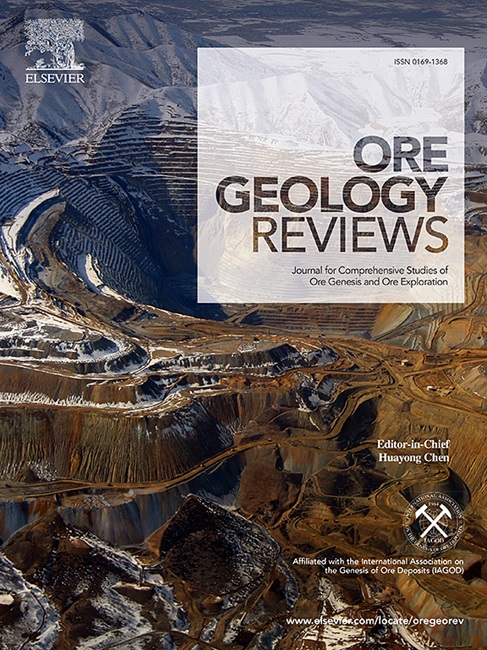不同成因独居石的结构、地球化学和U-Pb年代学:对南秦岭造山带龟岭沟斑岩型钼钨矿岩浆-热液演化的启示
IF 3.6
2区 地球科学
Q1 GEOLOGY
引用次数: 0
摘要
限制斑岩矿床岩浆-热液过程年代学的传统方法涉及使用两种或三种同位素系统(如锆石U-Pb,辉钼矿Re-Os或富k矿物40Ar/39Ar)。然而,使用不同的计时器和不同的关闭温度来估计这些过程的持续时间可能反映出基本的方法偏差,并且具有很大的不确定性。中国中部南秦岭造山带含有几个潜在的斑岩型钼钨矿床。龟岭沟矿床Mo-W成矿作用与四海坪二云母二长花岗岩侵位密切相关,四海坪二云母二长花岗岩的侵位是成矿的主体,其侵位驱动热液作用。四海坪岩体赋存矿体包括含矿石英(±绢云母)脉和含矿花岗质矿石,局部富独居石。岩浆独居石和热液独居石在结构、赋存方式和地球化学特征上有可靠的区别:①矿体中独居石体积较小,呈斑片状或无分带结构,而岩浆独居石一般体积较大,呈振荡分带或核圈结构,与典型的热液独居石特征一致;(2)在小范围内发现了高浓度的热液独居石颗粒,它们与矿石和其他热液矿物组合表现出共生关系。它们通常以半面体或半面体、亚圆形晶粒的形式出现,通常表现为不规则和不连续的生长。岩浆独居石以单晶形式出现,呈自面体锥体状,相对稀疏但分布均匀,充填于成岩黑云母、亚面体长石和石英之间的小孔隙空间。(3)与岩浆型独居石相比,热液型独居石的REE模式更陡,低重稀土富集、低重稀土亏缺,LREE/HREE比值更高,Eu异常强度和变化较小。岩浆型独居石的Th/U和Gd/YbN比值较为集中,微量元素之间存在一定的相关性,而热液型独居石的Th/U和Gd/YbN比值变化较大,两者之间没有相关性。(4)电子探针元素图显示,热液独居石中Ce含量均匀且高,全粒中Th、U、Y和SiO2含量极低,而岩浆独居石中Y含量高,且Ce、Th和SiO2呈强烈振荡带。岩浆独居石晶体的加权平均206Pb/238U年龄为205±0.6 Ma,表明成矿前存在岩浆活动。热液独居石晶体的加权平均206Pb/238U年龄分别为200±0.9 Ma和201±1.5 Ma,反映了贵岭沟蚀变/成矿的时间。这表明桂林沟斑岩体系从岩浆活动到热液流动的时间约为4 Myr。这个时间框架为勘探者评估斑岩系统的成矿潜力提供了一个额外的工具。本文章由计算机程序翻译,如有差异,请以英文原文为准。

Texture, geochemistry and U–Pb geochronology of monazite of different origins: Implications for the magmatic–hydrothermal evolution of the Guilingou porphyry Mo-W deposit, South Qinling Orogen, central China
Traditional methods for constraining the chronology of magmatic–hydrothermal processes in porphyry deposits involve the use of two or three isotopic systems (such as zircon U–Pb, molybdenite Re–Os, or K-rich mineral 40Ar/39Ar). However, the durations of such processes estimated using different chronometers with different closure temperatures could reflect fundamental methodological biases and have large uncertainties. The south Qinling Orogen in central China contains several potential porphyry Mo–W deposits. In the Guilingou deposit, the Mo-W mineralization is closely related to the emplacement of the Sihaiping two-mica monzogranite, which hosts the mineralization and whose emplacement drove hydrothermal processes. Orebodies hosted in the Sihaiping pluton include ore-bearing quartz (± sericite) veins and ore-bearing granitoid ores, which are locally rich in monazite. In this study, we provide reliable distinctions in terms of texture, mode of occurrence and geochemistry between magmatic and hydrothermal monazite, as follows: (1) Monazites in orebodies are relatively small and have patchy or unzoned structure, in contrast to magmatic monazites, which are generally large in size and have oscillatory zoning or core–rim structure, and are consistent with the features of typical hydrothermal monazites. (2) High concentrations of hydrothermal monazite grains are found within small regions, where they display paragenetic relationships with ores and other hydrothermal mineral assemblages. They generally occur as subhedral to anhedral, sub-rounded grains and commonly appear as irregular and discontinuous overgrowths. In contrast, magmatic monazites occur as single crystals with a euhedral pyramidal shape and are relatively sparse but uniformly distributed, filling small pore spaces between diagenetic biotites, subhedral feldspars, and quartz. (3) Compared to magmatic monazite, hydrothermal monazite shows steeper REE patterns, greater enrichment in LREEs and depletion in HREEs, with higher LREE/HREE ratios, and less intense and variable Eu anomalies. Magmatic monazites have concentrated Th/U and Gd/YbN ratios and show some correlations between the corresponding trace elements, whereas hydrothermal monazites have variable ratios and no correlation between the elements. (4) Elemental mapping by electron microprobe analysis shows homogeneous and high Ce contents in the hydrothermal monazite, together with extremely low Th, U, Y and SiO2 contents in the whole grains, in contrast to magmatic monazites, which have high Y contents and are strongly oscillatory zoned with respect to Ce, Th and SiO2. The magmatic monazite crystals obtained a weighted mean 206Pb/238U age of 205 ± 0.6 Ma, indicating a magmatic event prior to ore formation. Hydrothermal monazite crystals have weighted mean 206Pb/238U ages of 200 ± 0.9 Ma and 201 ± 1.5 Ma, which are interpreted to represent the timing of alteration/mineralization at Guilingou. This indicates a duration of ca. 4 Myr from magmatism to hydrothermal fluid flow for the Guilingou porphyry system. This time frame provides an additional tool for explorers to assess the metallogenic potential of the porphyry system.
求助全文
通过发布文献求助,成功后即可免费获取论文全文。
去求助
来源期刊

Ore Geology Reviews
地学-地质学
CiteScore
6.50
自引率
27.30%
发文量
546
审稿时长
22.9 weeks
期刊介绍:
Ore Geology Reviews aims to familiarize all earth scientists with recent advances in a number of interconnected disciplines related to the study of, and search for, ore deposits. The reviews range from brief to longer contributions, but the journal preferentially publishes manuscripts that fill the niche between the commonly shorter journal articles and the comprehensive book coverages, and thus has a special appeal to many authors and readers.
 求助内容:
求助内容: 应助结果提醒方式:
应助结果提醒方式:


